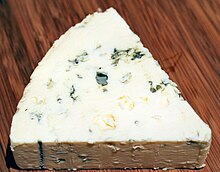| Danablu | |
|---|---|
 | |
| Other names | Danish Blue |
| Country of origin | Denmark |
| Source of milk | Cows |
| Texture | Semi-soft |
| Aging time | 8–12 weeks |
| Certification | Danablu: PGI |
|
| |
Danablu, often marketed under the trademark Danish Blue Cheese within North America, [1] is a strong, blue-veined cheese. [2] This semi-soft creamery cheese is typically drum- or block-shaped and has a yellowish, slightly moist, edible rind. Made from full fat cow's milk and homogenized cream, it has a fat content of 25–30% (50–60% in dry matter) and is aged for eight to twelve weeks. [1]
Before ageing, copper wires or rods are used to pierce the formed curds to distribute the mould ( Penicillium roqueforti) evenly through the cheese. The holes can still be seen when the finished wheel is cut open.
Danablu was developed early in the 20th century by a Danish cheese maker named Marius Boel with the intention of emulating a Roquefort-style cheese. Danablu has a milder flavor characterised by a sharp, salty taste, and is often served crumbled on salads or as a dessert cheese with fruit. In Denmark, it is often served on bread or savory biscuits.
Danablu, Danbo and Esrom are the only three Danish cheeses that are PGI-marked by the EU, [3] meaning that they may be produced only in Denmark from Danish milk and at approved dairies that produce the cheeses according to the specifications laid down.
See also
References
- ^ a b "Council Regulation (EC) No 510/2006 Amendment Application According to Article 9 'Danablu' EC No: DK-PGI-0217-0328-21.02.2011" (PDF). Official Journal of the European Union. Archived from the original (PDF) on August 30, 2019. Retrieved December 22, 2014.
- ^ "Danablu - Danish PGI cheeses". Archived from the original on 2014-08-25. Retrieved 2014-10-19.
- ^ "Blåskimmel og Danablu - Bliv klogere på blåskimmelost her | Mejeri". Archived from the original on 2016-04-28. Retrieved 2014-12-25.